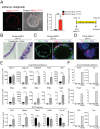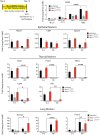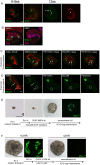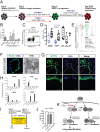Pluripotent stem cell differentiation reveals distinct developmental pathways regulating lung- versus thyroid-lineage specification
- PMID: 28947536
- PMCID: PMC5702071
- DOI: 10.1242/dev.150193
Pluripotent stem cell differentiation reveals distinct developmental pathways regulating lung- versus thyroid-lineage specification
Abstract
The in vitro-directed differentiation of pluripotent stem cells (PSCs) through stimulation of developmental signaling pathways can generate mature somatic cell types for basic laboratory studies or regenerative therapies. However, there has been significant uncertainty regarding a method to separately derive lung versus thyroid epithelial lineages, as these two cell types each originate from Nkx2-1+ foregut progenitors and the minimal pathways claimed to regulate their distinct lineage specification in vivo or in vitro have varied in previous reports. Here, we employ PSCs to identify the key minimal signaling pathways (Wnt+BMP versus BMP+FGF) that regulate distinct lung- versus thyroid-lineage specification, respectively, from foregut endoderm. In contrast to most previous reports, these minimal pathways appear to be evolutionarily conserved between mice and humans, and FGF signaling, although required for thyroid specification, unexpectedly appears to be dispensable for lung specification. Once specified, distinct Nkx2-1+ lung or thyroid progenitor pools can now be independently derived for functional 3D culture maturation, basic developmental studies or future regenerative therapies.
Keywords: Embryo; Endoderm; Lung; Nkx2-1; Pluripotent stem cells; Thyroid.
© 2017. Published by The Company of Biologists Ltd.
Conflict of interest statement
Competing interestsThe authors declare no competing or financial interests.
Figures







References
-
- Ahnfelt-Ronne J., Jørgensen M. C., Hald J., Madsen O. D., Serup P. and Hecksher-Sørensen J. (2007). An improved method for three-dimensional reconstruction of protein expression patterns in intact mouse and chicken embryos and organs. J. Histochem. Cytochem. 55, 925-930. 10.1369/jhc.7A7226.2007 - DOI - PubMed
-
- Crane A. M., Kramer P., Bui J. H., Chung W. J., Li X. S., Gonzalez-Garay M. L., Hawkins F., Liao W., Mora D., Choi S. et al. (2015). Targeted correction and restored function of the CFTR gene in cystic fibrosis induced pluripotent stem cells. Stem Cell Rep. 4, 569-577. 10.1016/j.stemcr.2015.02.005 - DOI - PMC - PubMed
-
- Dame K., Cincotta S., Lang A. H., Sanghrajka R. M., Zhang L., Choi J., Kwok L., Wilson T., Kańdula M. M., Monti S. et al. (2017). Thyroid progenitors are robustly derived from embryonic stem cells through transient, developmental stage-specific overexpression of Nkx2-1. Stem Cell Rep. 8, 216-225. 10.1016/j.stemcr.2016.12.024 - DOI - PMC - PubMed
-
- De M. L., Spencer-Dene B., Revest J., Hajihosseini M., Rosewell I. and Dickson C. (2000). An important role for the IIIb isoform of fibroblast growth factor receptor 2 (FGFR2) in mesenchymal-epithelial signalling during mouse organogenesis. Development 127, 483-492. - PubMed
Publication types
MeSH terms
Substances
Grants and funding
LinkOut - more resources
Full Text Sources
Other Literature Sources
Molecular Biology Databases

